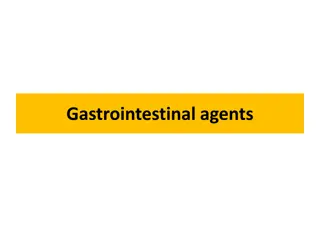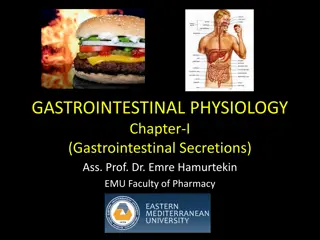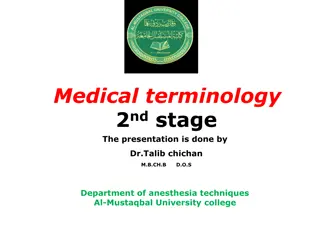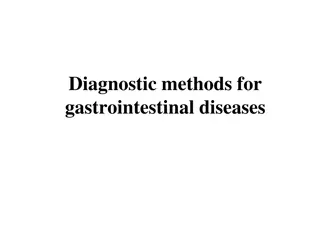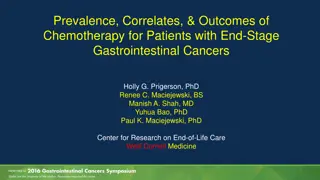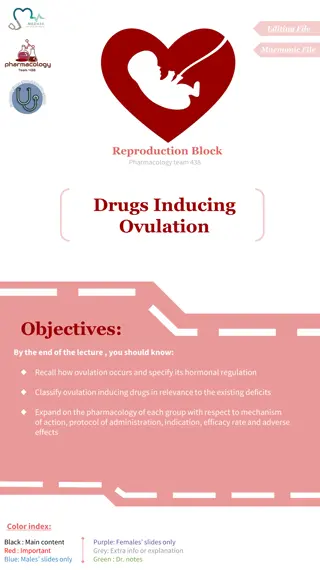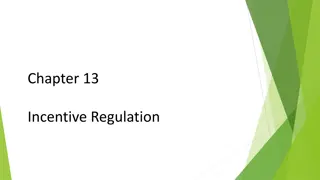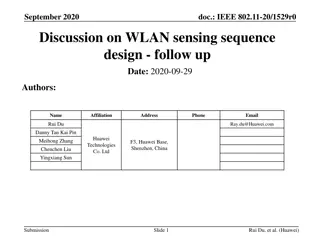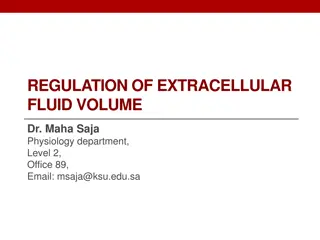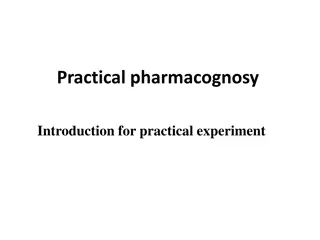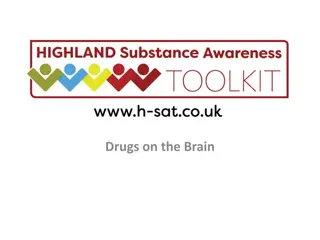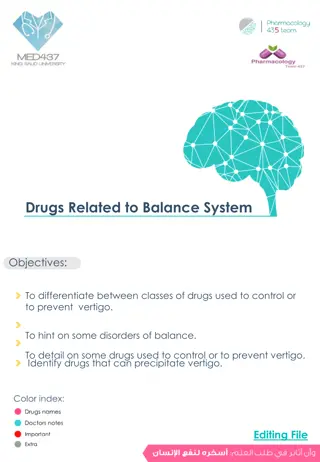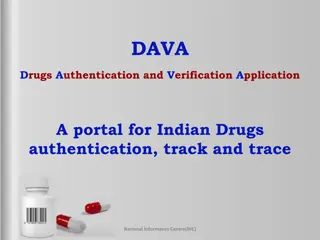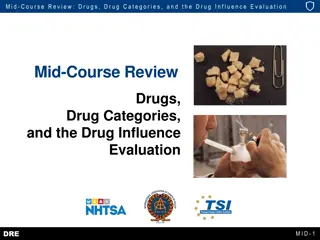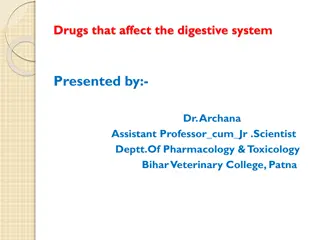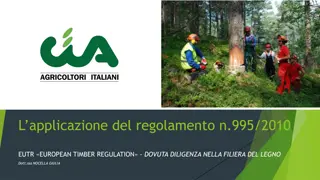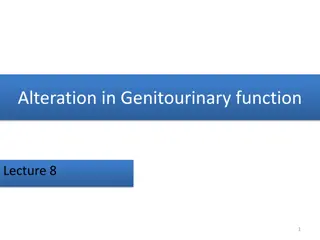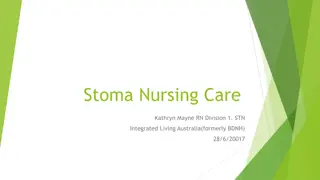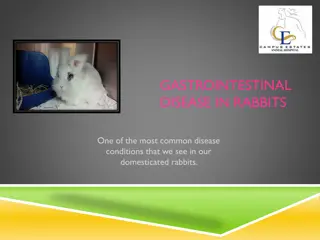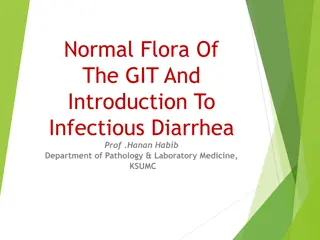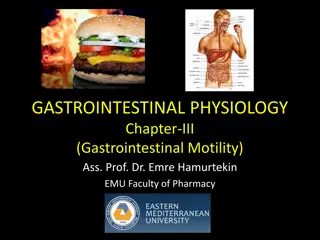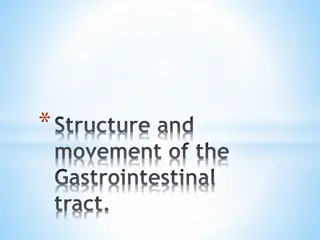Understanding Gastrointestinal Function and Its Regulation by Drugs
The gastrointestinal tract, a muscular tube from the mouth to the anus, is influenced by drugs affecting its function. Structures vary in different animals, with control by the autonomic nervous system branches. Parasympathetic stimulation increases motility, while sympathetic stimulation decreases it. Common GIT diseases like constipation, bloat, and ulcers can occur. Drugs like sialagogues increase salivary gland secretion, while bitters have different classifications based on their bitter taste effects on the GI system.
Download Presentation

Please find below an Image/Link to download the presentation.
The content on the website is provided AS IS for your information and personal use only. It may not be sold, licensed, or shared on other websites without obtaining consent from the author. Download presentation by click this link. If you encounter any issues during the download, it is possible that the publisher has removed the file from their server.
E N D
Presentation Transcript
Drug affecting on gastrointestinal function The term gastrointestinal muscular tube that begins at the mouth and ends at the anus. :Structure Oral cavity Esophagus Stomach Small intestine Large intestine
Drug affecting on gastrointestinal function Structures vary from 1. monogastric animals with simple stomach 2. ruminant animals with complex stomachs (Rumen,Reticulum,Omasum.Abomasum) 2. One control mechanism of the GI tract is the autonomic nervous system (parasympathetic and sympathetic branches)
Parasympathetic stimulation increases intestinal motility, increases GI secretions, and relaxes sphincters Cholinergic drugs simulate these actions Anticholinergic drugs inhibit these actions Sympathetic stimulation decreases intestinal motility, decreases GI
Commen Disease for GIT 1.Constipation 2.Bloat 3.Gastritis 4.Gastrointestinal obstruction 5.Hemorrhagic Gastroenteritis 6.Inflammation of large intestine(Colitis) 7.Gastrointestinal Ulcers
Sialagogues Sialagogues : Drugs which increase the secretion of salivary gland . It classified into two groups : a-indirect action b-direct action a-indirect (reflexly) acting sialagogues : acting on vagal nerve , the reflexes from the taste buds when stimulated cause increased secretion of saliva and gastric juice .
Bitters Are classified into three groups : 1-aromatic bitters : include compound tincture of gentian , extract of orange peel and gentian powder . 2-simple bitters : like quassia . 3-compound bitters : like compound tincture of gentian and some alkaloids which have bitter taste e.g. quinine , strychnine and ipecacuanha .
Bitters b-directly acting sialagogues : 1-directing acting on parasympathetic .e.g. pilocarpine , physostigmine . 2-directly acting on secretary cells .e.g. potassium iodide , . Na-salicylate .
Antisialagogues Antisialagogues : Drugs which either prevent salivation or depress salivation . -e.g. tannic acid ( depress the secretary cell ). -atropine (act on parasympathetic ) .
Appetizer ( appetite stimulants ) These drugs which stimulate appetite like vitamin B-complex , corticosteroid , anabolic steroids , nux vomica. Indication : in case of anorexia .
Antacids Antacids : -they are drugs which neutralize part of the hydrochloric acid in the stomach . -they are indicated in ulcer therapy , minor stomach irritations ,and other conditions depending on the type of antacid prescribed .these include : Sodium bicarbonate : I is used as a gastric antacid.
Antacids Magnesium oxide : -it is used as antacid and ( laxative ) -a side effect associated with mg . oxide is diarrhea . Aluminum hydroxide and Magnesium : -are used as a gastric antacid and as an agent in ulcer therapy . -in ruminant are used to treat rumen acidosis .
Carminative They are drugs which facilitate the expulsion of gas from the stomach or rumen . it's useful mainly in ruminant that produce large amount of gases during fermentation of carbohydrate , these gases are normally removed by belching but when this mechanism is disturbed , carminative are to be used :
Indication: bloat gaseous bloat , frothy bloat . e.g. volatile oil such as oil of turpentine , volatile drugs such as ether and alcohol and preparation ammonia .
Antizymotic antizymotic : drugs which kill or inhibit ruminal bacteria ,and prevent fermentation of carbohydrate and gas production e.g. formalin - volatile oils - antimicrobial : -tetracycline and streptomycin . - copper sulfa to kill protozoa .
Emetics Emetics : Drugs which stimulate vomiting center . -emetics can divided in to two classes according to the mechanism of action into : 1-central emetics( direct ). 2-reflex emetic ( indirect or local ). 1-central emetics :agents which stimulates the vomiting center in the medulla oblongata directly or indirectly through stimulation of the CTZ(Chemoreceptor Trigger Zone). Like Apomorphine
2-Indirect emetics : the agents that stimulate the sensory nerve ending of the vagel nerves in the stomach , duodenum and other organs , like : - Ipecacuanha a plant which contains the alkaloids emetine and cephaline , when given by mouth , produces emesis within 15 -30 min.
Side effect:lacremation ,conjunctivitis,increase bronchial secreation and sweating. -Zinc and copper sulphate , when given 1%solution produce emesis within a few min. slowly absorbed , it's preferable drug in case of poisoning .
Antiemetic Antiemetic : drugs which prevent or alleviate nausea and vomiting . Indcation of anti emetics are typically used to treat motion sickness and the side effects of opioid analgesics , general anesthetics.Intestine obstraction,ureamia.
Antiemetic include : -5HT5 receptor antagonists : these block serotonin receptors in the central nervous system and gastrointestinal tract . e.g. dolasetron. -Dopamine antagonists :act in the brain and are used to treat nausea and vomiting associated with radiation sickness, opioids neoplastic disease(phenothiazine,Metoclopramide) . -Antihistamine drug : including phenothiazine derivatives like promethazine , trimeprazine . -anticholinergic drug : like hyoscine .
cholagogues Cholagogues: Drugs stimulate liver to secretion bile.substance which increase production of bile called choloretics agent e.g.bile salts.
Stomachic Stomachic : Drugs which stimulate the secretion of pancreatic enzymes in case of their deficiency . 1-tablets : known as pancreatin are used for this purpose , they are especially coated to resist digestion in the stomach and contain lipase , trypsin and amylase . 2-bile salts : passing in the duodenum cause the liberation of secretion , which stimulates pancreatic secretion .
The purgatives (laxatives ) : are foods , compounds or drugs taken to induce bowel movements or to loosen the stool , most often taken to treat constipation . -certain stimulant , lubricant , and saline laxatives are used to evacuate the colon for rectal and bowel examinations , and may be supplemented by enemas in that circumstance . -
laxatives only work to hasten the elimination of undigested remains of food in the large intestine and colon
Types of the purgatives 1-simple bulk purgative : eg.a.indigeatale fiber(pectin,cellulose).b.agar-agar japans sea weed it used in cat and dogs. 2-saline bulk purgative . e.g. Mg sulphate , phosphate , oxide , carbonate ,powerful saline purgative . dangerous in case of horses . -Sod. Sulphate , used for horses and cattle given by stomach tube because it has it undesirable taste .
3-lubricant ( emollient ) : .e.g. liquid paraffin . 4-irritant ( stimulant ) : .e.g. Castor oil , senna, rhubarb . 5-anionic purgative : . e.g. Dioctyl sod. Sulphosuccinate . 6-enemata : e.g. sodium chloride , soap and glycerin
Adsorbant Adsorbant : Are substances which stick to the surface of undesirable bowel contents like gases and poisons to protect the gut mucosa and facilitate removal of toxic substance . e.g. kaolin (aluminum silicate ) , mg trisilicate , prepared chalk .
Astringents Are drugs which precipitate proteins forming an insoluble layer on the mucous membrane , this layer protects the mucosa from irritation and inhibit exudation , secretion and small hemorrhage . astringents there are two types : 1-metallic astringents : like salts of iron and copper used intestinal astringent .
Salts of lead , zinc and aluminum used topically (in the skin) 2-vegetable astringents : which act by liberating tannic acid precipitate proteins forming a protective layer forming protective layer like catechu
Antidiarrheal agent Antidiarrheal agents : diarrhea can also be treated by the administration of preparation containing crude opium , such as tincture of opium or powdered opium in which the alkaloid morphine acts by increasing the tone of the intestinal muscle and delays the movement of digest along the alimentary tact
Antispasmodic Antispasmodics : drugs that used to relieve spasm by reducing intestinal motility also used to reduce the intestinal secretion. Parasympatholytic :preparation of belladonna that contain atropine and hyoscine . Morphine derivatives : e.g.diphenoxylate and loperamide.
Prokinetics Prokinetics stimulants : Drugs increase the motility of a parts of the gastrointestinal tract. This enhance the transit of material through the tract .
Prokinetics dopaminergic antagonists : Used in veterinary medicine include metoclopramide and domperidone , these agent stimulate motility of the gastro esophageal sphincter , stomach and the small intestine -serotonergic drugs : Cisapride is used in veterinary medicine . is stimulates motility including the gastro esophageal sphincter ,stomach , small intestine and colon. -Motilin like drugs :


